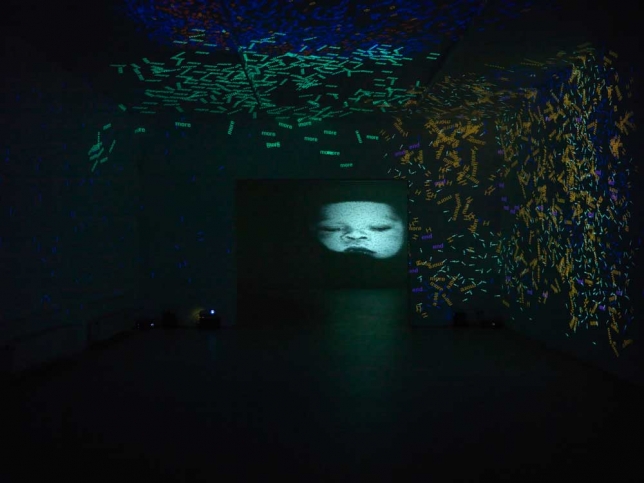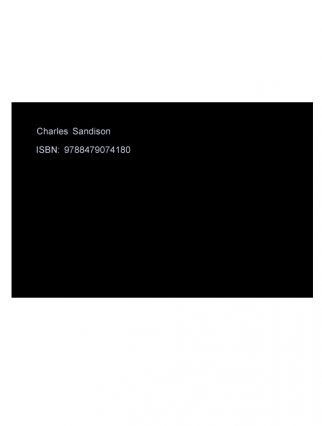04.12. – 13.01.07
Charles Sandison
“Cryptozoologies”
Solo exhibitions at Arndt & Partner, Berlin
Charles Sandison
born in 1969 in the UK (Scottish)
lives and works in Tampere, Finland
Charles Sandison transports viewers into the fascinating world of the labyrinthine complications of language. Words and symbols dance, float, meet and mingle across the walls of the darkened gallery and the whole structure of the exhibition space. Sometimes aggressive, hasty and then slow and peaceful again, it seems as if the words have acquired a life and logic of their own. In the middle of the kaleidoscopic swarms of words we feel as though we have landed in the middle of the mouth of thought itself, in which the words become the protagonists of a story about the origin of being. Their movements seem random at first, but on closer inspection, we discover that they possess an individual choreography that resembles a digital simulation of the systems of nature and civilisation, a poetic illustration of the binary code that forms their basis. In a simple but eloquent way they reveal the extent to which our language and indeed our whole system of thought rest on primordial binary structures such as light and dark, good and evil, male and female, natural and artificial, open and closed, dead and alive. Projected against the wall, the ephemeral form in which they are presented again serves to underline the fleeting nature of thought and images, which can be perpetually reinvented and put together in an infinite number of ways.
His façade projection “Proclamación Solemne” at the Grand Palais, Paris caused as much attention a his solo show "Correspondances: Sandison – Monet” at the Musée d'Orsay Art contemporain, Paris (both 2008).
Recently his work „The Blind Watchmaker“ has been on view at the presentation of the Burger Collection in Berlin and he participated in the group show „Embrace!“ at the Denver Art Museum, Colorado, USA (both 2009). His façade projection “Proclamación Solemne” at the Grand Palais, Paris caused as much attention a his solo show "Correspondances: Sandison – Monet” at the Musée d'Orsay Art contemporain, Paris (both 2008).
Sandison has participated in important international group exhibitions at ZKM, Karlsruhe, Germany (2004), Kiasma Museum of Contemporary Art, Helsinki (2004), Museum of Art, Lucerne, Switzerland (2005), and the Kunstmuseum Bonn, Germany (2006), among others. Most recently, his work was represented at the Shanghai Biennial 2006. Sandison has also had numerous solo exhibitions e.g. at the Kiasma Museum of Contemporary Art, Helsinki (2004), the Centre pour l’image contemporain, Geneva, and the Fundación La Caixa, Palma Mallorca, Spain (both 2006).
EXHIBITIONS:
29.4. - 30.5.2010
“Changing The World”
Group exhibition with worky by Erik Bulatov, Sophie Calle, William Cordova, Wim Delvoye, Anton Henning, Thomas Hirschhorn, Ilya und Emilia Kabakov, Jitish Kallat, Jon Kessler, Karsten Konrad, Julije Knifer, Enrique Martinez Celaya, Josephine Meckseper, Vik Muniz, Muntean Rosenblum, Julian Rosefeldt, Charles Sandison, Dennis Scholl, Nedko Solakov, Hiroshi Sugito, Ena Swansea, Mathilde Ter Heijne, Keith Tyson, Ralf Ziervogel, (ARNDT, Berlin)
04.12. – 13.01.07
Charles Sandison
“Cryptozoologies”
at Arndt & Partner, Berlin
8.12.- 29.01.2006
Charles Sandison
"The Blind Watchmaker and Other Stories"
Arndt & Partner, Zurich
 Charles Sandison, Zur Farbenlehre (Data for a Theory of Color), 2010, Single channel data projection, dimensions variable, edition / 5 + 1AP
Charles Sandison, Zur Farbenlehre (Data for a Theory of Color), 2010, Single channel data projection, dimensions variable, edition / 5 + 1AP Charles Sandison – SYSTEMATIC – group show at Projectspace 176 – Zabludowicz Collection
 Charles Sandison, installation view of “Reading Glass” and "Blind Watchmaker” at Projectspace 176, Zabludowicz Collection; Photo: Stephen White
Charles Sandison, installation view of “Reading Glass” and "Blind Watchmaker” at Projectspace 176, Zabludowicz Collection; Photo: Stephen White
SYSTEMATIC
group show at Projectspace 176
Zabludowicz Collection
1 July - 15 August 2010
For Systematic, Sandison has developed two existing works, adapting them for the idiosyncratic architecture of 176. In Reading Glass, the full stops of a text emerge from the flaws and irregularities of the room and come together to form the words of Charles Darwin’s On the Origin of Species (1859). Their behaviour mimics that of bacteria, coming together, reproducing and dying out, as they spell one word after another, eventually going through Darwin’s entire text. The design of the letters is based on handwriting samples from Sandison’s daughter at the time when she was learning to write.
The Blind watchmaker (2005) borrows its title from a computer program developed by the evolutionary biologist Richard Dawkins in 1986, which is now used by the police to construct portraits of missing people. The program analyzes photographs to predict the way an individual would look at a later age. Sandison has reversed the programme to recover the features of a newborn’s face from photographs of adults.
Exhibitions
PRESS RELEASE
Arndt & Partner are pleased to present the solo show "Cryptozoologies" with works by Charles Sandison.
The Scottish artist Charles Sandison transports viewers into the fascinating world of the labyrinthine complications of language. Words and symbols dance, float, meet and mingle across the walls of the darkened gallery and the whole structure of the exhibition space. Sometimes aggressive, hasty and then slow and peaceful again, it seems as if the words have acquired a life and logic of their own. In the middle of the kaleidoscopic swarms of words we feel as though we have landed in the middle of the mouth of thought itself, in which the words become the protagonists of a story about the origin of being. Their movements seem random at first, but on closer inspection, we discover that they possess an individual choreography that resembles a digital simulation of the systems of nature and civilisation, a poetic illustration of the binary code that forms their basis. In a simple but eloquent way they reveal the extent to which our language and indeed our whole system of thought rest on primordial binary structures such as light and dark, good and evil, male and female, natural and artificial, open and closed, dead and alive. Projected against the wall, the ephemeral form in which they are presented again serves to underline the fleeting nature of thought and images, which can be perpetually reinvented and put together in an infinite number of ways.
In "Living Rooms", the installation Sandison brought to the Finnish pavilion at the Venice Biennial 2001 and which led to his international breakthrough, the artist let the whitely illuminated words Male, Female, Food, Father, Mother, Child, Old and Dead glide across the darkened exhibition walls. The words refer to the basic elements of our existence: men rival for food; upon maturity they seek the company of women and children are born; when population numbers threaten to explode, deadly viruses appear; but even without those, society ages and gradually dies a natural death. The beginnings and the end of life merge in an organic flow of time and space, in the midst of and as a prisoner of which, human beings see and reflect upon themselves.
The installation "Family" (2006), recently shown at the Shanghai Biennial, has a similarly schematic structure. Here the viewer is surrounded by a blizzard of Chinese characters. The existential dynamics of the piece work irrespective of the cultural context. But as we see in the exhibition "The Book of Light" (Fundación La Caixa, Palma Mallorca, 2006) in which he covered the whole building with Biblical quotes, it is the themes of the Christian, Western world Sandison reverts to time and again.
Despite their profoundly metaphorical nature, the works of Sandison also have a sense of humour to them, as we see in the installation "Lumière" (2006). Here we find ourselves facing a large-format, wall-filling abstraction of rhythmically moving variation of sketchily drawn and darkly opaque surfaces. It is only after contemplating these for a while that we realize we are looking at people. They are abstracted copies of a home video of a family holiday, pictures of the beach, of people and gulls and the sea, dissolved in a sea of black and white symbols. And here too, the title of the piece can be interpreted as a witty reference both to the Lumière brothers on the one hand, who at the beginning of the 20th century invented the world's first film projector, the cinématographe, with which they first projected motion pictures; and on the other, to the Finnish word "lumi" meaning snow, i.e. a time of year of extreme light and dark contrasts. With a gentle wink, Sandison takes us to his chosen home of Finland, which he loves primarily for the winter, the tremendous length of it and the concentration on elementary contrasts it imposes on all who live there.
Charles Sandison, born in Scotland in 1969, lives and works in Tampere, Finland. Sandison has participated in important international group exhibitions at ZKM, Karlsruhe, Germany (2004), Kiasma Museum of Contemporary Art, Helsinki (2004), Museum of Art, Lucerne, Switzerland (2005), and the Kunstmuseum Bonn, Germany (2006), among others. Most recently, his work was represented at the Shanghai Biennial 2006. Sandison has also had numerous solo exhibitions e.g. at the Kiasma Museum of Contemporary Art, Helsinki (2004), the Centre pour l'image contemporain, Geneva, and the Fundación La Caixa, Palma Mallorca, Spain (both 2006).
8.12.- 29.01.2006
Charles Sandison
"The Blind Watchmaker and Other Stories"
Solo exhibition at Arndt & Partner, Zurich
PRESS RELEASE
The installations created by the Scottish artist Charles Sandison immerse the beholder into a fascinating synthetic world made up of projected words and signs floating across the room. In the dark, they silently wander across the architecture and the beholder as shining dots of light, sometimes in a hurry, sometimes at a slow pace, sometimes isolated and then, again, in dense swarms. At first sight, the caleidoscopic movements of the light signs seem to be arbitrary. After some time, however, they either densify to form figurative silhouettes embedded in a sort of narration apparently inspired by the Poésie Concrète, or they reveal a choreography that reminds of biological or civilizational systems being translated into a digital simulation.
The title of Charles Sandison's first solo exhibition at Arndt & Partner, Zurich, was borrowed from the computer program "The Blind Watchmaker" that was developed by the biologist Richard Dawkins in 1986. This program has been used by Dawkins as a model to illustrate his Darwinistic theory of evolution. It simulates the complex mechanisms of selection and adaptation biological forms of life are going through. Fascinated with such simulations, Charles Sandison defines the laws governing the behavior of his shining signs in computer programs that he compiles for each of his works individually. He reserves some potential for changes and deviations that are based on coincidence and generated by the program itself. This is how he enables the choreographies of his works - in contrast to looping video projections - to be continually modified in a partly aleatory, partly determined manner.
His ephemeral light projections, that might well be read metaphorically as well, enable Charles Sandison to successfully reconcile opposites such as poetry and codification, the organic and the digital, or the reading of text versus the experience of physical space.
Charles Sandison (born 1969 in Scotland) lives in Tampere, Finland. His works were presented in the following solo exhibitions, among others: Yvon Lambert, New York (2005), Wäinö Aaltonen Museum, Turku, Finland (2004), The Lisson Gallery, London (2004), Centre d'Art Contemporaine Georges Pompidou, Cajarc, France (2003), and the Galerie Frank, Paris (2003). Furthermore, Sandison took part in numerous group exhibitions held, among others, at the Kunstmuseum Luzern and the Kunsthalle Lophem, Loppem-Zedelgem, Belgium (both in 2005), the ZKM-Zentrum fur Kunst und Medien in Karlsruhe, Germany, at the Museum der Moderne, Salzburg, the Moderna Museet, Stockholm (all of these three in 2004), the Museum Morsbroich, Leverkusen, Germany (2003), and the 49th Venice Biennial (2001).

